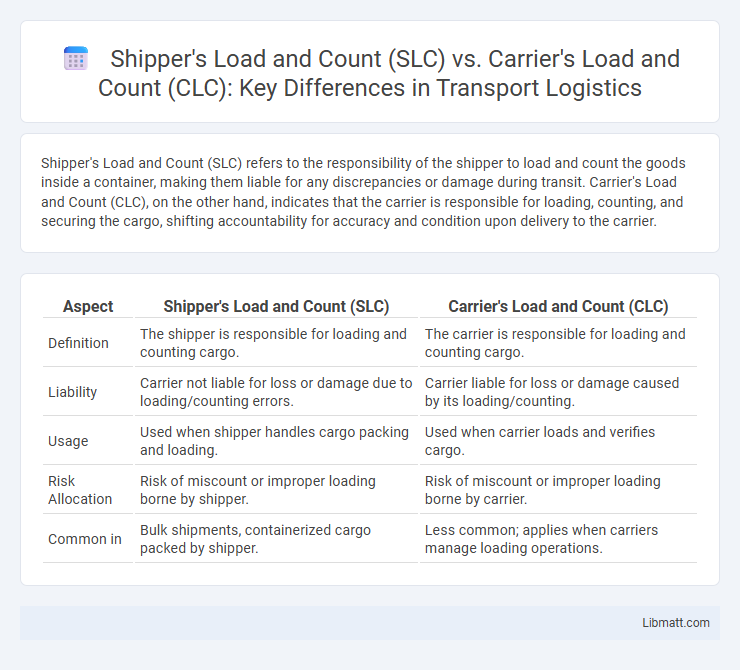Shipper's Load and Count (SLC) refers to the responsibility of the shipper to load and count the goods inside a container, making them liable for any discrepancies or damage during transit. Carrier's Load and Count (CLC), on the other hand, indicates that the carrier is responsible for loading, counting, and securing the cargo, shifting accountability for accuracy and condition upon delivery to the carrier.
Table of Comparison
| Aspect | Shipper's Load and Count (SLC) | Carrier's Load and Count (CLC) |
|---|---|---|
| Definition | The shipper is responsible for loading and counting cargo. | The carrier is responsible for loading and counting cargo. |
| Liability | Carrier not liable for loss or damage due to loading/counting errors. | Carrier liable for loss or damage caused by its loading/counting. |
| Usage | Used when shipper handles cargo packing and loading. | Used when carrier loads and verifies cargo. |
| Risk Allocation | Risk of miscount or improper loading borne by shipper. | Risk of miscount or improper loading borne by carrier. |
| Common in | Bulk shipments, containerized cargo packed by shipper. | Less common; applies when carriers manage loading operations. |
Introduction to SLC and CLC
Shipper's Load and Count (SLC) indicates that the shipper is responsible for packing and verifying the contents of the shipment, with the carrier relying on the shipper's accuracy. Carrier's Load and Count (CLC) means the carrier handles the loading and verifies the count, assuming responsibility for the shipment's integrity during transit. Understanding these terms is crucial for determining liability and accuracy in logistics and freight operations.
Definition of Shipper’s Load and Count (SLC)
Shipper's Load and Count (SLC) refers to the responsibility of the shipper for the loading, packing, and counting of cargo before handing it over to the carrier. This term indicates that the carrier accepts the shipment without verifying the quantity or condition of the goods inside the container. Your liability as a shipper includes ensuring accurate loading and proper documentation to avoid claims or disputes during transportation.
Definition of Carrier’s Load and Count (CLC)
Carrier's Load and Count (CLC) is a shipping term indicating the carrier's responsibility for verifying and counting the cargo loaded onto the transport vehicle. Under CLC, the carrier accepts liability based on the number of packages or units they physically load and seal, rather than relying on the shipper's declaration. Your understanding of CLC helps clarify accountability in cases of loss or damage during transportation, ensuring proper risk assessment.
Key Differences Between SLC and CLC
Shipper's Load and Count (SLC) indicates that the shipper is responsible for loading and counting the goods before shipment, which limits the carrier's liability for cargo discrepancies. Carrier's Load and Count (CLC) means the carrier takes responsibility for loading and counting, increasing their accountability for any damage or loss during transit. The primary difference lies in liability allocation: SLC shifts responsibility to the shipper, while CLC places it on the carrier, affecting claims and risk management in freight shipping.
Legal Implications of SLC and CLC
Shipper's Load and Count (SLC) places the responsibility for accurate cargo counting and loading on the shipper, significantly limiting the carrier's liability for any discrepancies or damages unless caused by negligence. Carrier's Load and Count (CLC) shifts this responsibility to the carrier, holding them liable for the accuracy and condition of the cargo upon receipt and during transit. Legal disputes often hinge on these terms as they define the extent of carrier accountability under transportation contracts and liability regimes such as the CMR Convention or U.S. Carmack Amendment.
Responsibilities Under SLC Terms
Under Shipper's Load and Count (SLC) terms, the shipper is responsible for the correct loading, proper securing, and accurate counting of the cargo loaded into the container or transport unit. The carrier assumes responsibility only once the sealed container is received, with liability limited as they rely on the shipper's declared quantity and condition. This shifts risk to the shipper for discrepancies in load weight, quantity, or concealment of damage prior to shipment.
Responsibilities Under CLC Terms
Under Carrier's Load and Count (CLC) terms, the carrier assumes full responsibility for the accuracy of the cargo count, weight, and condition once it is loaded. This means the carrier must ensure proper stowage and safeguarding of the goods, taking accountability for any discrepancies or damages during transit. Your contract with the carrier under CLC demands rigorous inspection and verification procedures before the vessel departs to avoid liability issues.
Risks and Liabilities: SLC vs CLC
Shipper's Load and Count (SLC) places the responsibility for load accuracy and count on the shipper, reducing carrier liability for cargo shortages or damages during transit. Carrier's Load and Count (CLC) shifts this liability to the carrier, as they verify and accept the cargo load and count, increasing their risk if discrepancies occur. Your choice between SLC and CLC significantly impacts who is legally accountable for inventory issues, loss, or damages during shipping.
Best Practices for Shippers and Carriers
Shippers should ensure accurate documentation and detailed packing lists to support Shipper's Load and Count (SLC) declarations, minimizing disputes over cargo responsibility. Carriers benefit from conducting thorough inspections and verifying shipment details for Carrier's Load and Count (CLC) to mitigate liability and enhance cargo security. Both parties should implement real-time tracking technology and maintain clear communication channels to optimize accountability and streamline claims resolution.
Conclusion: Choosing Between SLC and CLC
Choosing between Shipper's Load and Count (SLC) and Carrier's Load and Count (CLC) depends on your desired level of liability and control over the cargo. SLC shifts responsibility for loading accuracy and count to the shipper, reducing carrier liability but requiring meticulous documentation from your side. CLC places the carrier in charge of loading and verification, increasing their accountability but potentially exposing you to higher risks if discrepancies occur during transit.
shipper’s load and count (SLC) vs carrier’s load and count (CLC) Infographic

 libmatt.com
libmatt.com